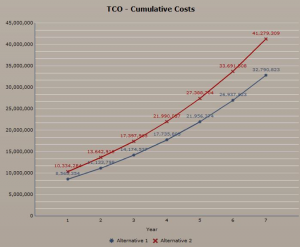This website uses cookies so that we can provide you with the best user experience possible. Cookie information is stored in your browser and performs functions such as recognising you when you return to our website and helping our team to understand which sections of the website you find most interesting and useful.
Data is critical to organizations and companies is a conclusion reached by most everyone. In the different groups, there is wide variation in what is required to provide the necessary infrastructure to store, access, and manage information. Decisions to implement infrastructure require an understanding of the economics of information – what are the costs, what is the value of the data, and what is the time horizon. The scale or the amount of data can magnify less than optimal decisions made. This is why these decisions are strategic – setting a cost and capability for managing and storing information will have long term economic impact.
Economics for Strategic Decision-Making
- What is the lifespan of data? Lifespan in this case is how long will that data be retained. The answer to that can vary but for the majority, the assumption is that most data will be retained if not forever, at least for the foreseeable future.
- What is the lifespan of the storage system for that data? Another very interesting question and one that is changing with persistent memory technologies but the important aspect is that the lifespan of the storage system is almost always less than the data that will be stored, accessed, and managed.
- How long will the data management software be used? Most IT personnel do not have a ready answer for this, representing the periodic nature of when data management software changes. Data management in this case includes moving data based on changing value and costs, ensuring availability of access, and protecting data according to business requirements.
These questions point out that economic decisions need to have a time element. The cost for storing and managing information is a continuum and not specific to the lifespan of the storage system and software. The selection of the storage and management solution will be a major factor in that cost, especially with the lifespan of the solution and the transition costs. From experience, the time horizon needs to be seven or ten years. The seven or ten year timeframe will cover a technology transition and fits into the strategic planning timeline for executives. For evaluating the economics of storing and managing information, an economic evaluation using TCO (Total Cost of Ownership) elements that represent the cost of storing, accessing, and managing information is the most practical measure. Representation of the cost should be cumulative, showing an ongoing cost over that horizon.
In the calculation of cost for storing, accessing, and managing information or TCO for short, the cost factors to be considered are crucial in creating a credible model. Hard costs – those that are real expenditures need to be detailed and accounted for during the time covered. The hard costs represent real product prices, operational costs, etc. These need to be numbers that can withstand scrutiny and challenge. Without this assurance, the economic decisions to be made may be challenged as well. Some of the hard costs to consider are:
- Hardware
- Hardware maintenance / support
- Software
- Software maintenance / support
- Administration
- Power and cooling
- Space
- Deployment
- Data migration
- Network / leased line costs
Soft benefits from a solution, those that cannot have a definitive number, should not be included. These would be challengeable numbers and could possibly invalidate the economic evaluation or create a degree of skepticism. Again, only hard costs and benefits should be included. These numbers need to have a yearly cost and then represented as cumulative costs over the time horizon. The changes in demands such as increasing amounts of data, increase in overheads, and decrease in device costs should be factored in on an annual basis.
 The costs should be a comparison between the current status quo meeting demands over time versus one or two other solutions. Three alternatives can be represented effectively and understood. As more alternative solutions are added, the ability to understand and consider the alternatives clearly becomes difficult.
The costs should be a comparison between the current status quo meeting demands over time versus one or two other solutions. Three alternatives can be represented effectively and understood. As more alternative solutions are added, the ability to understand and consider the alternatives clearly becomes difficult.
A simple example of a TCO cumulative chart follows. Other examples are available at https://labs.futurumgroup.com/services/financial-models/
Summary
Making decisions about storing, accessing, and managing information have long-term economic implications because of the longevity of the data. Continued growth in the amount of information amplifies any decision. Solutions must be evaluated not only on their technical capabilities but on the long-term economics.
An economic analysis can be done to enable making an informed decision. The economic analysis produced can be used not only in making the selection of the solution but, importantly, for justification of the expenditure. The economic-based decision is an investment in that valuable organization or company asset: data.

